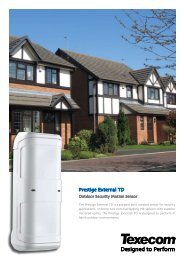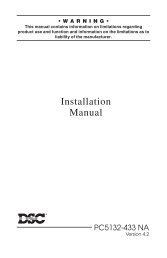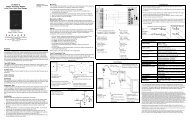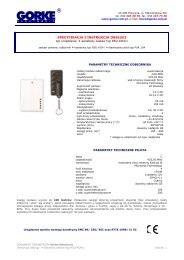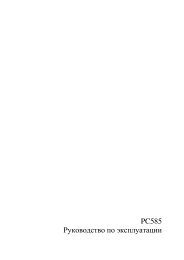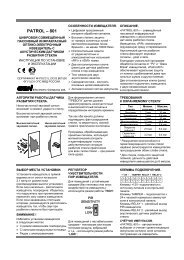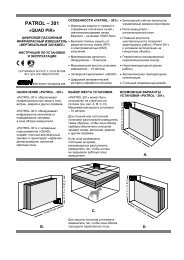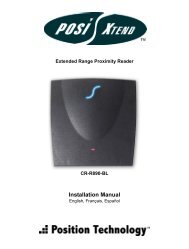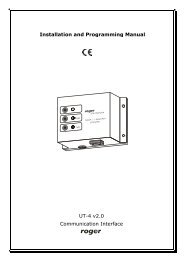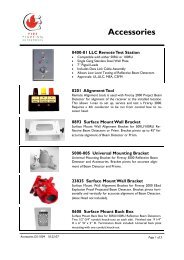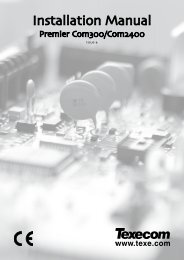CONVENTIONAL FIRE PANELS - Kotesa
CONVENTIONAL FIRE PANELS - Kotesa
CONVENTIONAL FIRE PANELS - Kotesa
- No tags were found...
You also want an ePaper? Increase the reach of your titles
YUMPU automatically turns print PDFs into web optimized ePapers that Google loves.
The Control panel will activate the DL output whenthe programmed Alarm Signalling delay expires.During Alarm status, Key and PIN Code users (AccessLevel 2 — refer to “Access to signalling and commands”)will be able to: stop the Silenceable outputs by pressing the Silencekey.During Silence status (Silence LED glowing), it is possibleto use the Silence key to release the Silenceableoutputs, and the Reset key to restore standby status.If the Control panel is in Night Mode (Night ModeLED glowing), the Control panel will exit Silencestatus when the programmed Night mode Silencetime expires.Trouble This Control panel can detect and signal thefollowing Trouble: Input zone shorted or open; Supervised zone shorted or open; Control panel blocked; Output 24V or 24R shorted; Low battery, battery trouble or disconnected battery; Ground fault; Communication trouble with peripherals; Mains failure.Fault conditions will be signalled by: a slow intermittent beep (at 1 second intervals); glowing on the Fault LED; fast blinking on the LED of the “component” concerned(the Logic Unit LED will glow to signal “Controlpanel blocked”); activation of the Fault output (TROUBLE terminals); Negative pull-down to 0 V on OC terminal, that is, if itis programmed to signal Fault.The Fault output (TROUBLE terminals) and OC outputs(if duly programmed) will restore to standby automaticallywhen fault conditions clear.Under certain circumstances, fault conditions may clearspontaneously, if this occurs, the event will be stored inthe memory until the Control panel Resets.Stored Fault events will be signalled by: slow blinking on the LEDs of the “component” concerned.Silence This Control panel provides a Silence keywhich can be used to restore the Silenceable outputs tostandby status: R1, R2, ..., R8 NAC1 and NAC2 ALARM TROUBLESilence status will be signalled by: an audible signal (lasting 1 second) followed by along pause (lasting 5 seconds); glowing on the Silence LED.Silence status will be held until the Silence key is pressedagain or, if the Control panel is operating in NightMode, until the programmed Night mode Silence timeexpires, or until a new Alarm or Trouble condition is detected.ONLY Key and PIN Code Users (Access Level 2)can SILENCE the Silenceable outputs.Disable This Control panel provides keys which can beused to disable the bypassable inputs and outputs: Z1, Z2, ... Z24 can be used to bypass (exclude) theirrespective zones; Disab./Fault NAC can be used to bypass outputsNAC1 and NAC2; Disab./Fault Telecom can be used to bypass the DLoutput.DISABLED zones cannot generate alarms or warningsof any kind, and DISABLED outputs cannot be activated.Disabled status will be signalled by: glowing on the Disab. LED; glowing on the LED of the respective zone or output(see LEDs: Disabled/Fault/Test, Disab./Fault NACand Disab./Fault Telecom).ONLY Key and PIN Code Users (Access Level 2)can DISABLE zones and/or outputs.Reset Resetting the Control panel will restore the outputsto standby status, delete the memory, and interruptthe power supply to terminals Z1, Z2, ..., Z8 and 24R forthe programmed Reset Time.ONLY Key and PIN Code Users (Access Level 2)can Reset the system. Fire alarms must be Silenced(via the Silence key) before Reset.Fault conditions can be Reset directly (via the Resetkey). InterfaceVisual Signalling The system status will be signalledon the Control panel LEDs as follows:GREEN indicates normal operating conditions;AMBER indicates specific operating modes (for exampleDay or Night mode), and/or Fault conditions;RED indicates Alarm conditions.Memory The Control panel will signal Alarm/Faultevents until the system Resets, even if the event clearsin the meantime.Stored events will be signalled by: slow blinking on the LED concerned.Display The J424 Control panel can house theJ400-LCD Module. This module provides written informationregarding the system status, and the cause offaults on inputs and outputs (short-circuit, interruptionetc.).INTRODUCTION 7



